| Our tour
begins at the northwest corner of Fifth Avenue and Waverly Place,
across from the Washington Arch. Cross the street and enter the
park. |
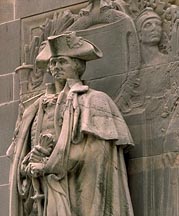 |
1
Washington Square Park & Arch
This is the heart of the Village and the
main gathering place for Villagers and visitors alike. Park history
goes back to 1797 when the area was designated as a pauper's burial
ground. The site was also popular with early New Yorkers as a
dueling ground, and was used for public executions. A large tree in
the northwest corner of the park is the famous (or infamous) Hanging
Elm, said to be the oldest tree in the city. In 1826 the Square was
officially designated as the Washington Military Parade Ground.
Surrounding properties soon developed into a fashionable residential
area. |
The Arch, the work
of Stanford White, was built in 1891-92 to celebrate the 100th
anniversary of Washington's inauguration as President. It replaced
an earlier wooden arch, built in 1889, which spanned Fifth Avenue
just north of the present arch. In 1916, John Sloan, the father of
the "Ashcan School" of painting, with a group of art students and
fellow bohemians, forced open a doorway on the arch leading to an
interior stairway. Upon reaching the top of the arch, they built a
fire, lit colorful Japanese lanterns and declared the independence
of the state of "New Bohemia".
In late May and early September, the Washington Square Outdoor Art
Exhibit is held around the park. |
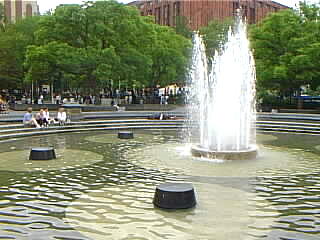 |
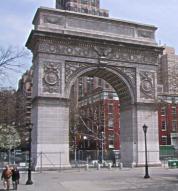 |
As you wander around the park, notice the bocce courts, chess
tables, dog run and playgrounds. In the warmer months you will find
musicians strumming guitars, magicians, comedians and acrobats
putting on impromptu performances around the central fountain.
Now proceed to the north side of the park, west of Fifth Avenue
to:
|
2 20
Washington Square North
This Federal-style home was the first house
to be built on the north side of the Washington Parade Ground. The
original structure, built in 1828 - 29 was widened in 1859, and had
a fourth story added in 1880. The "Flemish Bond" brickwork is a sign
of the Federal style of construction: laying the bricks with the
ends and sides alternating to the front. This was thought to be the
only way to tie the expansive face brick to the interior bricks in
the customary twelve-inch thick walls. "Running Bond" became the
practice by the mid-nineteenth century.
The Greek Revival style houses at Nos. 21-26 are what remains of a
group of houses built for the social elite of the Village in the
1830s. Along with a group of houses down the road, on the other side
of Fifth Avenue, they are know as "the Row". Henry James's novel
Washington Square, written in 1881, had it's setting in his
grandmother's house, the since demolished No. 18.
Turn right on Macdougal Street and proceed half-way up the block: |
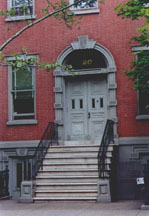 |
3 Macdougal Alley
Just off MacDougal Street. between
Washington Square North & West 8th Street
The charming, small-scale houses along this private street were
built as stables in the 1850s for the wealthy residents of 8th
Street (then called Clinton Place) and Washington Square. Poet Edwin
Arlington Robinson wrote his famous Tristram at No. 1, winning
himself his third Pulitzer Prize. Jackson Pollock stayed in No.9 in
1949-50. 15 1/2-17 1/2 was the first site of the Whitney Museum. In
front of No.15 is one of New York’s last gaslight. |
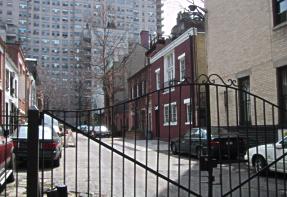 |
Continue up
Macdougal, turn right on W. 8th Street, then left on Fifth Avenue.
Proceed to W. 10th Street. Turn left:
Mark Twain lived at No.14 at the turn of the century.
Continue west to: |
4
20-38 West 10 Street
This "terrace" of brownstone houses was
built in 1856 - 58 in the Anglo-Italianate style. 0riginally all
were 4-1/2 stories in height with unifying balconies at the second
floor and English style basements with entrances under the stoop.
Retrace your steps to the corner of Fifth Avenue. |
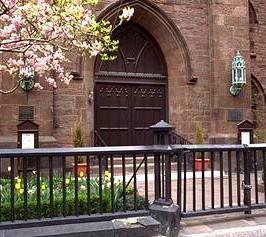 |
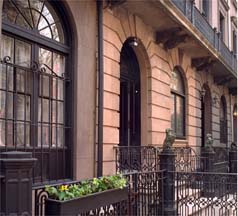 |
5
Church of the Ascension
Fifth Avenue at West 10th Street
This English Gothic Revival style church was designed and built of
brownstone in 1840. It was thought at the time that brownstone best
recreated the centuries of grime seen on the cathedrals of Europe.
Continue north on Fifth Avenue across W. 11th Street |
6
First Presbyterian Church
Fifth Avenue between 11th and 12th
Street
This is an early example of the Gothic revival style with pointed
arches, foliate finials and great tower. It was designed by Joseph
C. Wells. The church opened for worship in 1846 for a congregation
originally formed in 1716.
Carefully cross Fifth Avenue to: |
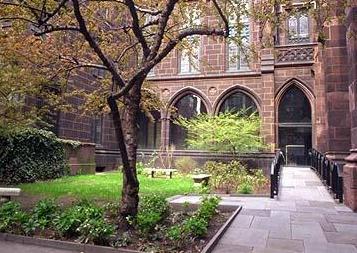 |
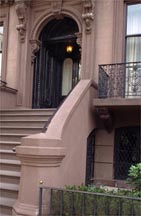 |
7
Salmagundi Club
57 Fifth Avenue
Built in 1852, this is the last survivor of the imposing private
homes which once lined lower Fifth Avenue and is an outstanding
example of Italianate style. Since 1917 it has been home to the
Salmagundi Club, an artists' club founded in 1871.
Again crossing Fifth Avenue, go one block further north to:
8 Forbes Magazine Galleries
62 Fifth Avenue
Here you will find the collections of the late Malcolm Forbes,
including fabulous Faberge eggs, and historic Presidential documents
and signatures. And don't miss the marvelous collection of toy
boats, tin and lead soldiers, and early Monopoly games. The Gallery
is open from 10 am - 4 pm on Tuesdays, Wednesdays, Fridays and
Saturdays. Free. |
|
Return to W. 12th and turn right. Half-way down the block you'll
find: |
9
The New School
for Social Research
66 West 12th Street
Designed by Joseph Urban in 1930, this building with its black and
white horizontally striped facade, is one of the earliest examples
of Modern architecture in Manhattan. The school was founded in 1919
by refugees from the Bolshevik Revolution, who were joined in the
1930's by refugees from Hitler's Germany.
Continue on to Sixth Avenue (Avenue of the Americas), turn left
and left again onto W. 11th Street. Look over the wall on the south
side of the street, just east of the corner. |
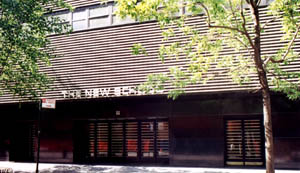 |
 |
10 Second Cemetery
of the Spanish & Portuguese Synagogue
West 11th Street, East of Sixth Avenue
Some original tombstones, including a small stone obelisk, remain
in this plot which, from 1805 to 1829, was part of the
congregation's larger cemetery. In 1830 when the City opened up West
11th Street, the congregation petitioned it for the portion of the
cemetery that would not interfere with the street. This small
triangular plot is all that remains.
Return to Sixth Avenue and turn left. One block south, across W.
10th Street, on the far side of Sixth Avenue, you'll notice a red
brick building with an impressive tower.
Cross Sixth Avenue to get to the: |
11
Jefferson Market Library
Sixth Avenue & West 10th Street
This landmark was built in the 1870's on the site of an earlier
market. It is replete with Victorian Gothic details; ornate
sculptured gables, banded brick and stonework, turrets, belfry, and
four-faced clock. In the 1880's the courthouse was voted one of the
nation's most beautiful buildings.
The garden behind the market was the site of an early market and
fire look-out tower. Later it was a site of a women’s prison. Today
the garden is a community project of the Village Committee for the
Jefferson Market Area. The building now house's a branch of the New
York Public Library.
In the late 1940's Sixth Avenue was officially renamed Avenue of
the Americas. However to most New Yorkers and throughout this guide
it is known as Sixth Avenue. The round shields of the Pan-American
states lining the Avenue were dedicated in 1947 by President Harry
S. Truman.
Take a quick detour left onto West 10th Street. |
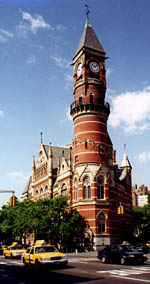 |
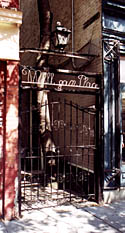 |
12
Patchin Place
North side of West 10th Street, between
Sixth and Greenwich Avenues
Built in 1848 as boarding houses, this secluded enclave once was
home to Theodore Drieser and e.e. Cummings.
Return to Sixth Avenue and turn left. Look for an iron gate on
your left, a few buildings up from West 10th Street.
13 Milligan Place
West side of Sixth Avenue between West 10th & 11th Streets
Another picturesque courtyard built in 1852 as boarding houses.
Turn left onto West 11th Street, and continue to Seventh Avenue. |
14 St.
Vincent's Hospital
East side of Seventh Avenue, between
West 11th & 12th Streets
Founded in 1849, the hospital was the City's first charity
hospital. Survivors of the Titanic were treated here in 1912.
Cross Seventh Avenue, and proceed down West 11th Street for one
block to Waverly Place. |
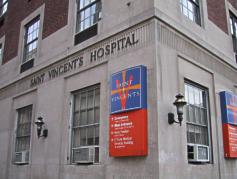 |
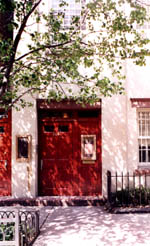 |
15 St.
John's in the Village
Corner of Waverly Place and West 11th
Street
This red brick church, completed in 1974, replaced an 1847 Greek
temple-style church that burned in 1971. The present church echoes
the Nineteenth Century style. Today the building is elaborately
wired for theatrical productions. The parish hall serves as a much
used community center.
Continue on West 11th Street to Bleeker, nothing along the way the
curious corner of West 4th Street and West 11th Street; the streets
of Greenwich Village were laid out before the street grid system
found in the rest of Manhattan was established, making the area west
of Seventh Avenue confusing even to many native New Yorkers. |
| Turn left at
Bleecker Street. |
16 Bleeker Street from West 11th Street to Grove Street
Most of the structures in this five-block
area were built between 1820 and 1855. Today many have interesting
shops and quaint restaurants on their lower floors.
Turn right on Grove Street, and proceed one block to the corner of
Bedford Street. |
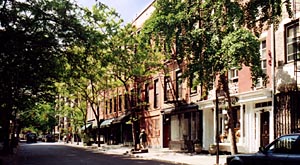 |
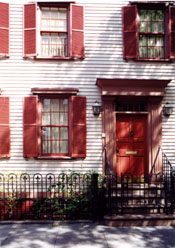 |
17
14-16 Grove Street
This picturesque frame house was built in
1822 for sash maker William F Hyde. The little cottage around the
corner on Bedford Street, erected in 1823, has always been part of
the property.
Cross Bedford, and continue on Grove Street to: |
18 2 1/2 TO
10 Grove St.
Partly hidden from the street behind a
wall, these two-and-one-half-story houses in Federal style show the
scale of original Village structures. Of frame construction with
brick fronts in Flemish bond, these houses were built between 1825
and 1834. All have been faithfully kept to the original design,
except for the one at 2 1/2 Grove St.
Follow Grove to where it ends at Hudson Street; cross Hudson to: |
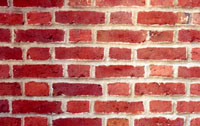 |
19
St.Luke-in-the-Fields
487 Hudson Street
Built in 1821-22 as an "uptown" chapel of Trinity Parish, this
Federal-style brick church is Manhattan's third oldest church
building. Built on farmland donated by Trinity Parish, the St.
Luke's block is an early example of community planning. A few years
later town houses were built on all sides, enclosing the burial
ground and garden.
Proceed one block north on Hudson, and turn left onto Christopher
Street. Follow Christopher one block to the corner of Greenwich
Street. Across the street you will notice an impressive red brick
building. |
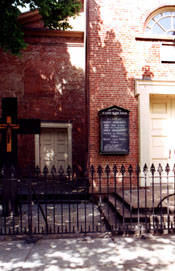 |
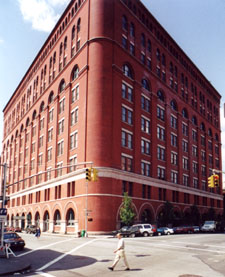 |
20
Federal Archive Building
Greenwich Street between Christopher and
Barrow Streets
Known to Villagers as "The Archives," this massive red brick
structure, completed in 1899, is out of scale by Village standards.
Its great arches and massive piers at street level show the heavy
masonry required to support tall buildings before the steel skeleton
came into general use. The building, a United States appraiser's
warehouse, was built facing the docks. It is now an apartment house
with its entrance on Greenwich Street.
Turn left on Greenwich Street, left again onto Barrow Street, and
continue 2 blocks, re-crossing Hudson Street, to Bedford Street. The
house on the near right hand corner is: |
21
Isaac- Hendricks House
77 Bedford Street
Built in 1799, this is the oldest remaining house in the Village.
It was originally a free standing Federal style frame house with its
own yard. The Greek Revival brick facade was added in 1836.
Next to the Isaacs-Hendricks on Bedford Street you'll find a small
treasure: |
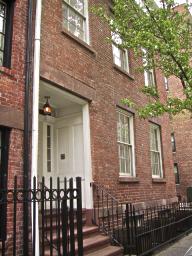 |
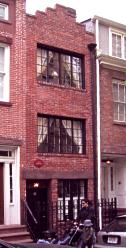 |
22 75 1/2 Bedford Street
“Narrowest House”
Less than ten feet wide this is the City's
narrowest house. It was built in 1873. Edna St. Vincent Millay lived
here between 1923 and 1924.
At the next corner, turn right onto Commerce Street. |
23
9-17 Commerce Street
This group of small houses, along with the
neighboring houses across the street, suggests the scale of the
Village in the early Nineteenth Century. The houses are
unpretentious versions of late Federal design of the 1820’s. There
is also a suggestion of the incoming Greek Revival style in their
facades. Washington Irving Jr. allegedly wrote Sleepy Hollow while
staying at No. 11, the home of his sister.
Commerce Street may look like it comes to a dead end, but take a
walk down it, and you will see that it goes around a corner,
depositing you back on Barrow Street. Turn left on Barrow, retracing
your steps to Hudson Street. Turn left onto Hudson, and continue for
two blocks, turning left into St. Luke's Place (also called Leroy
Street). |
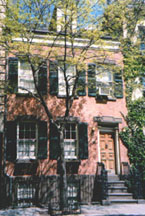 |
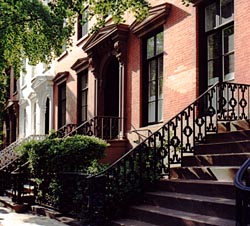 |
24
5-17 St. Luke's Place
This is an imposing row of 15 Italianate
town houses, constructed on a master design for well-to-do merchants
between 1851 and 1854. The ironwork, arched doorways, long French
windows, and bracketed roof cornices are especially notable.
Novelist Sherwood Anderson lived at No.12 in 1923. Poet Marianne
Moore lived at No. 14(1918-1929); in 1925, she became editor of The
Dial. Painters Paul Cadmus and Jared French lived at No.15; in 1947,
novelist E.M. Forster stayed with them while visiting New York. No.
16 was the home of Novelist Theodore Dreiser; he began writing An
American Tragedy while living here.
The James J. "Jimmy" Walker Park across the street is named for
the former Mayor who lived at 6 St. Luke's Place. |
Walk down St.
Lukes’ Place to Seven Avenue South.
Turn left onto Seventh Avenue South, continuing to the
intersection of Seventh Avenue South, Bleeker & Barrow Streets.
Carefully cross Seventh Avenue South and turn right onto Barrow
Street. |
25
Greenwich House
27 Barrow Street
Built in 1917, this Georgian Revival brick building is home to a
settlement house founded in 1902, by Mary Kingsbury Simkhovitch,
Jacob Riis, Carl Schurz, Felix Adler and others, to uplift the
then-decaying neighborhood. Greenwich house sponsors Day-Care,
Health Care, Music, Craft and other programs for the community.
Continue on Barrow Street to West 4th Street. Across the Street
you will see: |
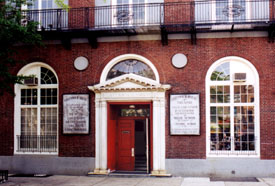 |
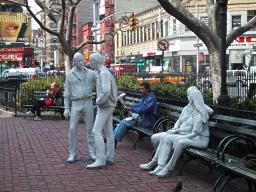 |
26
Sheridan Square Viewing Gardens |
Triangle at the intersection of Washington Place, West 4th and
Barrow Streets
This triangle was originally used by local Indians as a trading
post. In the 1920’s and 30’s, it was home to Cafe Society Downtown,
a famous nightclub and speak-easy.
Turn left onto West 4th Street and proceed to the corner of
Seventh Avenue South. |
27
Christopher Park
Triangle at the intersection of
Christopher and Grove Streets and Seventh Avenue South
Christopher Park was founded in 1837 and features a statue of
Civil War General Philip Sheridan. Villagers and tourists alike
often call this triangle "Sheridan Square." Two sculptures by George
Segal grace the park.
At the east end of the park, you’ll notice an unusually shaped,
red-brick building. |
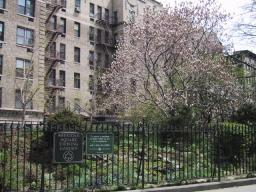 |
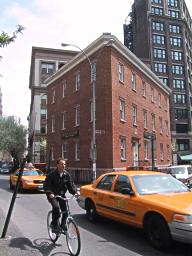 |
28
Northern Dispensary
Triangle formed by Waverly Place,
Christopher Street, and Grove Street
This Georgian triangular structure was built in 1831. It is the
only building in New York, or perhaps anywhere, with one side on two
streets (Grove and Christopher) and two sides on one street (Waverly
Place).
The Dispensary was founded by local citizens in 1827 to provide
health care for the poor in what was then the northern end of the
City, hence the name. In 1837 Edgar Allen Poe was treated here.
Look up at the street sign at the intersection of Christopher,
Grove and Waverly Place, and you’ll notice an altogether different
name: |
29
Stonewall Place
Christopher Street between Waverly Place
and Seventh Avenue South
In 1969 police raided "The Stonewall Inn," a gay bar on
Christopher Street. The patrons rebelled and a riot ensued. This
first rebellion, and accompanying press coverage gave birth to the
gay and lesbian movement. This portion of the Street has since been
renamed " Stonewall Place".
Turn right on Christopher Street, and in two blocks turn right
onto: |
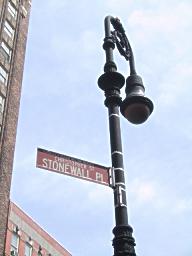 |
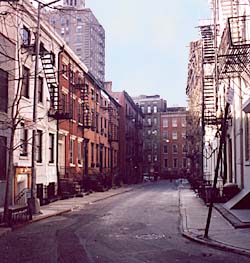 |
30 Gay
Street
Between Christopher Street & Waverly
Place
This exceptionally well-preserved and charming little street
opened in 1833. This street was a stop on the Underground Railroad.
A century or so later it was the locale for the films My Sister
Eileen and Carlito’s Way.
The street was named in honor of Sydney Howard Gay, managing
editor of The New York Tribune during the Civil War. Mr. Gay was an
avid abolitionist and hid runaway slaves in the press room. His
great granddaughter still lives in the Village.
Turn left at the end of Gay Street, onto Waverly Place, and then
right onto Sixth Avenue. One block down you will find: |
31
St.Joseph’s Church
Corner of Sixth Avenue & Washington
Place
Fluted Doric Columns dominate the entrance of this temple-style
church which was built in the 1830s of fieldstone in the Greek
Revival style. The two framed arched windows were added after a fire
in 1885.
This is the last stop on the tour of Greenwich Village west of
Washington Square Park. To return to the park, cross Sixth Avenue,
and walk one block to Washington Square. If you would like to
continue onto the tour of the areas east and south of Washington
Square, return to the Washington Arch at the top of the park. |
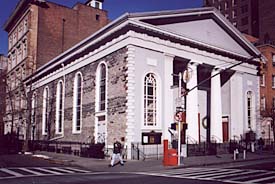 |
| Photographs
provided by © John & Wendy |
|
|
HISTORY
From the country estates of
Colonial times to the gay bars and thriving nightlife of today.
Greenwhich Village has always diverged from city norms. During the
mid-nineteenth century, the area thrived, as its residents commissioned
famous architects and artists to erect elaborate decorative structures
designed to house religious and educational institutions. As New York
University built around Washington Square and beautiful churces sprang,
the neighborhoods became host to art clubs, private galleries, learned
societis, literary salons and libraries and hotels, shops and theatres
eventually clogged lower Broadway. As the industrial revolution hit with
full force, the neighborhood declined, but its solid roots ensured that
the diversifying community would remain strong. Members of the working
classes mingled with the vestigal upper class, much as they do today.
As the art scene increased in importance, the Village's removal from the
financial constraints of Midtown's Broadway theaters and publishing
powerhouses resulted in the development of a phenomenon for which the
neighborhood would become worldfamous: the Bohemian lifestyle.
Experimental theater, galleries specializing in avant-garde art, and
irreverent "little magazines", the forerunners of today's "zines",
exploded onto the scene. Wild parties, candle-lit tearooms, novelty
nightclubs, and bizarre boutiques soon followed.
Just prior to the Depression, "artistic flats" became the era's local
euphemism for luxury apartments that displaced longtime residents, some
of whom had spawned the artistic revolution that first put the
neighborhood on the map.
Following the Depression's end, the Beat Generation arrived and the
Village saw the first stirring of gay culture. Once again, writers and
artists of all kinds congregated here, fueling the divergent but
intimately-connected genesis of the hippie movement and the gay
revolution. Counterculture survivor and novelist Norman Mailer started
the
Village Voice in 1955; the paper remains a leading organ of the
left wing throughout the city and beyond. Near the Village's
still-bustling Sheridan Square, a 1969 police raid on a local gay bar
resulted in the Stonewall Rebellion, a seminal moment in the developing
movement for gay and lesbian rights. With the eighties came the the AIDS
epidemic, which hit the the community hard and sparked increased
activism that continues today.
Sites & Parks
Elmer Bobst Library
and Study Center This massive twelve-storey
cube of steel and orande-tinted redstone was designed by Johnson & oster
to be the architectural focal point of NYU's main campus: only those who
can prove their affiliation with NYU may enter. The library's interior
maintains the austerity and cold eeriness of its facade with
chevron-like aluminum railings shaped like crucifixes and a black, grey
and white marble floor patterned after Palladio's piazza for Venice's
San Giorgio Maggiore. Make sure to check out the expansive Avery Fisher
Video Library collection on the second floor and the eleventh-floor
archive, which stores such treasures as a page from Gutenberg's original
printed Bible and ancient cuneiform stones
70 Washington Square Park South (between LaGuardia and Washington
Square East), A, B, C, D, E, F, Q to West 4th
Grace Church
Designed in 1846 by James Renwick, Jr. in a Gothic Revival style, Grace
is the city's greatest Episcopal church. NYU students in the residence
hall across the street whose windows face Broadway can wake up in the
morning to the sight of the church's climbing white marble spiral.
802 Broadway (at 10th), N, R to 8th St, 6 to Astor Place.
Loeb Student Center
Students resort to congregating at NYU's student center only when
desperate for a quick meal or to attend a university-sponsored event.
Until the administration makes good on its promise to renovate, these
are the only good reasons for venturing here.
566 LaGuardia Place (between 3rd and 4th), A, B, C, D, E ,F, Q to West
4th
The Meat-Packing
District
Tucked into the northern part of the West Village near the river, this
grid of streets, of which Gansevoort is the main artery, is the unlikely
heir to the city's fickle city's fickle title of hippest new 'hood. In
one of New York's classic juxtapositions, club parties and raves blow in
and out of the area, just a block or two from some of the Village's most
pristine streets and a few of its most famous residents. The area itself
was originally a farmer's market until the cow carcasses took over in
1949.
South of 14th Street (West of Greenwhich), F, L, , 1, 2, 3, 9 to 14th
St
Sheridan Square
A major hub of the West Village, the square gets noisy and raucous on
the weekends when its subway stop starts hatching nightcrawlers.
Between Seventh Ave, Christopher Street, West 4th St and Groove St, 1,
9 to Christopher
Washington Square
Park The unofficial center of NYU's
ever-expanding kingdom, the park is now almost unrecognizable as the
public gallows and potters field of its 1780 origins. The "hanging"
tree, a huge elm, still stands in the northwest corner of the park; the
walkways and fountains were added in 1850 and crowned by Stanford
White's famous memorial arch in 1892 for the centennial of George
Washington's inauguration. Most of the surrounding 19th century
Federal-style brownstones have been taken over by NYU; the elegant
houses known as "the Row" on Washington Square North, which now
accommodate universitybureaucrats, once housed such talents as
HenryJames. Today, the park hosts a representative mix of the West
Village populace, including guitar strumming musicians, petty drug
dealers, muttering old chess players and NYU students.
4th to 8th St, west of Broadway, A, B, C, D, E, F, Q to West 4th
Movies & Books
Ghostbusters,
dir. Ivan Reitman, 1984
The firehouse on 14 North Moore Street provided the exterior of Dan
Aykroyd, Bill Murray and Harold Ramis' makeshift headquarters.
Legal Eagles,
dir. Ivan Reitman, 1986
Debra Winger and Robert Redford defend Daryl Hannah at the New York
Courthouse at 60 Centre Street.
Cheap Thrills
Hanging Out
Take a seat on one of the many loaading docks for free relaxation,
sunbathing and people-watching. Make it a picnic by stopping at one of
the local gourmet delis for some inexpensive fresh produce and bread.
1, 9 to Franklin, 1, 2 to Chambers
TriBeCa Potters
Watch the artists at work at TriBeCa Potters and browse among the items
for sale between 9 am and 5:30pm
443 Greenwich Street, 1, 9 to Canal
Celebrity-Spotting
Peer through the windows of fancy eateries like TriBeCa Grill and NoBu.
Franklin Street (between Greenwich and Hudson Street) 1, 9 to Franklin
Observe-
Works-in-Progress
Hang around one of the many film or fashion fashion shoots; watch the
action and the actors/models and pick up some technical knowledge.
Community Concern
In the 70s, following the
classic model of SoHo, TriBeCa became part of of the Special Lower
Manhattan Mixed-Use District, designed to "permit light manufacturing
and controlled residential uses to co-exist where such uses are deemed
compatible." As a result, residents thought they could enjoy all the
amenities that came with commercial spaces, some within their own
buildings.
Dry-cleaners are a good example of such amenities, and zoning permits
stores larger than 2,000 square feet to move into locations convenient
for the residents of converted warehouses. But several recent studies on
the frequently-used chemical perchloroethylene, commonly known as "perc"
has residents of a North Moore Street luxury condominium in an uproar.
Spurred by reports that perc is a C2 carcinogen, a possible
cancer-causing agent, and that drycleaning stores expose 150,000 workers
and residents in New York State to 2,000 times the Health Department
guideline for maximum exposure to the chemical, the building is filing a
joint lawsuit against White Glove Valet, a dry-cleaner on the first
floor.
In an effort to address the lawsuit and mounting concerns citywide, a
State Supreme Court justice ruled soon afterwards that a state council
should examine whether city codes for dry-cleaners should be more
stringent. In the meantime, Joseph B. Rose, chairman of the City
Planning Commission, informed a New York Times reporter that he
had met with other officials "to examine whether city zoning needs to be
modified to address what we now know about harmful impacts of certain
land uses, like dry-cleaners."
But the dry-cleaners themselves have organized, and they won't budge. The
owner of the TriBeCa store refused to stop using perc, despite increased
neighborhood pressure. The Neighborhood Cleaners Association director,
William Seitz, firmly defends the use of perc, taking offense at the
notion that rezoning dry-cleaners to industrial areas would benefit the
community.
"In apartment houses, you have the shoe repair, the hardware store, the
dry-cleaner," Seitz argued. "To go back where we were fifty years ago is
to go back to the dark ages in terms of consumer preference and need."
Most residents and consumers remain unconvinced that convenience should
supersede safety. Besides, they argue, if perc is taken out and a more
environmentally-friendly method is used, no one needs to move anywhere. |